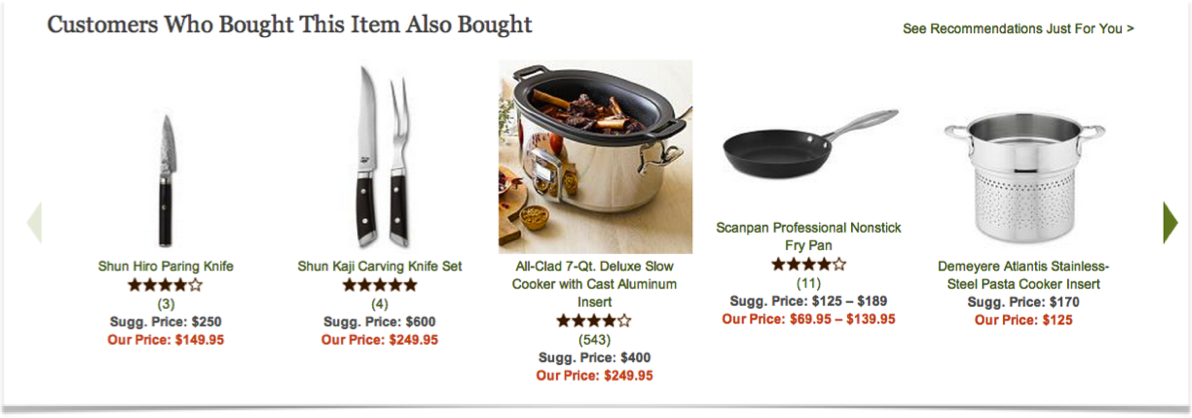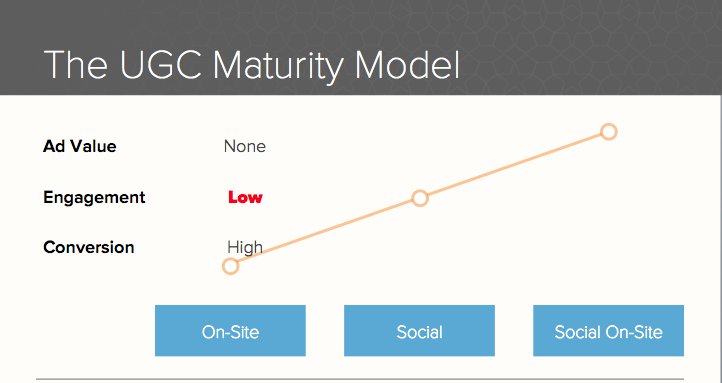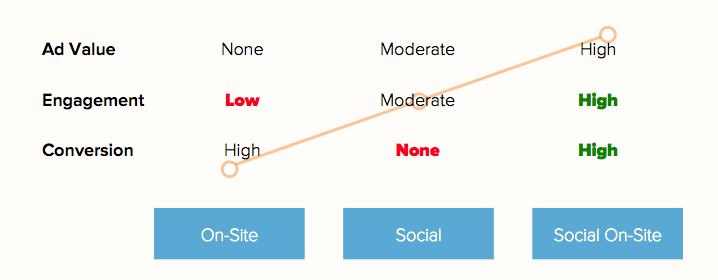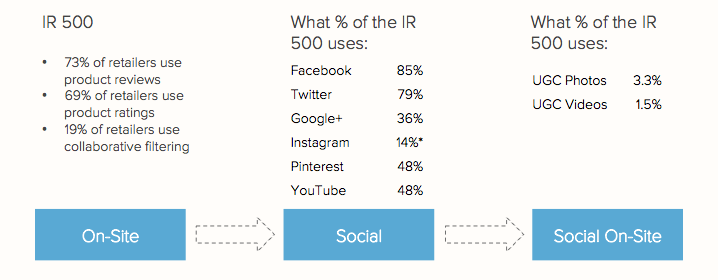Imagine you were walking into an Apple store for the first time. It’s completely empty except for a few employees wandering around and smiling politely. What do you do? Are you supposed to handle the products? What products are the most popular? Who are these products made for? Do you belong here? Whether we realize it or not, we rely on social cues to inform our actions, but online, these social cues are largely absent. In a sense, every customer is shopping in an empty store.
User generated content (UGC) is an invaluable tool in helping ecommerce retailers combat this feeling. Showing customer comments, photos, or even a list of the most popular items helps online retailers to bridge the gap between the digital and physical.
The Role of UGC in Your Ecommerce Strategy
UGC is any fan engagement that is repurposed by brands to drive sales and marketing efforts. Far and away the most popular forms of UGC are ratings and reviews, other forms include collaborative filtering (see Williams and Sonoma example below), customer photos, and customer videos.

Many forms of UGC are still in their infancy, but ratings and reviews have been around for some time and provide insight on just how impactful this kind of content is in influencing customer behaviors. A handy infographic, The Review of Reviews , compiles a list of impressive stats around the impact of ratings and reviews including:
- 71% of customers agree that consumer reviews make them more comfortable that they are buying the right product or service
- 70% of people consult reviews/ratings before purchasing
- 63% of people are more likely to purchase a product from a site if it has product ratings and reviews
- Customer reviews create a 74% increase in product conversion
Ratings and reviews placed on product pages are clearly quite effective at converting visitors into paying customers. But, as the model below shows, the challenge is that this content only exists on the company website and unless you’re Amazon, it can be tough to get high rates of engagement.

This is when the next stage in the UGC Lifecycle comes into play. Using social platforms, retailers no longer have to rely on pulling customers to their site and asking them to create content on company terms. Instead, the company can engage customers on their preferred platforms. At this point, it’s much easier to boost engagement and gain visibility in front of consumers who may not otherwise know who you are. Unfortunately, it’s harder to turn those eyeballs into conversions without a big, helpful BUY! button right next to a picture. This brings us to the final stage in the UGC Maturity Model.
The most clever companies are already successfully pulling social content onto their websites to get maximum value from customer-created content. At this stage, the content still exists on social platforms, but companies begin integrating the content onto their site to create a more engaging experience for existing customers.

Why Customers Love UGC
Up to this point, we’ve covered the benefits of UGC for retailers, but it’s important to note why customers love UGC as well. For customers, UGC performs four key functions:
- Social Proof: UGC provides social cues about a product a service, filling an important gap between the real and the digital world.
- Merchandizing: Models and product shots are nice, but people want to get a sense of how a product fits into their life. UGC provides a sense of tactility.
- Trust: Customers want to buy with confidence. UGC provides evidence that other people like you and your products.
- Fan celebration: It’s easy to get hung up on the squeaky wheels on social media, but you don’t want to miss acknowledging your raving fans. Pulling this type of UGC onto your website is a great way to give your customers a “platform” to share what they love.
The State of Social and User Generated Content Across the Top 500 Internet Retailers
Among the IR 500, UGC maturity is still quite low:

Understanding the value of UGC and effectively incorporating it on your website are two very different things. Embedding UGC on your website brings up questions like:
- How do you track if its working?
- What if customers post/share negative things?
- How to you make it super-easy for customers to purchase from UGC?
And while the IR 500 has been more hesitant to take on these questions, innovative brands are already reaping the benefits of pulling UGC onto their sites.
How Innovative Brands are Implementing UGC Today to Drive Sales and Engagement
Curalate joined us for a webinar yesterday to share some examples of how their clients are using UGC to boost engagement:
Ben & Jerry’s
Ben & Jerry’s invited users to snap pictures of their ice-cream faces and tag them with #captureeuphoria. Results of the campaign include: 15,000 images being submitted, 70 million impressions, and a 22% increase in Instagram followers during the first three months. Ben and Jerry’s then went on to build campaigns featuring submitted images. These campaigns were customized at the local level, making their customers the stars of the ads.
Rent the Runway
Rent the Runway shoppers were already uploading photos of themselves in their borrowed designer dresses to Facebook and Twitter, Rent the Runway just needed to harness the existing momentum. They began crowdsourcing these images to display on product pages. Doing this helped them overcome hesitancy about the very new idea of renting clothing. The campaign was a huge success, leading to a 200% increase in conversions.
Urban Outfitters
Urban Outfitters wanted to harness the high number of brand endorsements they were receiving on social platforms. They created an on-site UGC gallery of customer photos that links directly to the product page where the product is sold. This led to a time on-site increase of 45 seconds and 15% shopping rate improvement.
Getting Started
UGC is still in its infancy. For ecommerce retailers looking to get started, there are a few good ways to begin:
- Use an ecommerce platform with ratings and reviews built in. Ratings and reviews are expected and customers love them, make this a priority.
- Incentivize UGC on social media. Try some different contests and promotions on a variety of platforms and start testing what resonates with your customers.
- Once you have an understanding of the kinds of content your customers like creating you can start embedding UGC in your other business processes by experimenting with UGC calls-to-action both in-store on your product packaging.
If you’d like to learn more about using user generated content to boost conversions, check out a recording of our webinar, Fostering Engagement with User Generated Content.

